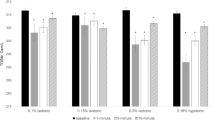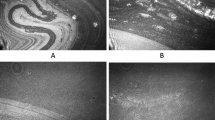Abstract
We used a freezing point depression method to determine the osmolalities of 502 non-stimulated 200-nanoliter tear samples. The samples were collected hourly at 9 times on each of 6 days. Four reference (tear prism) sites on the ocular surface were used: mid-superior, mid-inferior, and the tear prisms at the medial and lateral canthi. While 256 of the samples were from a young (25 year old) male volunteer having no complaints of dry eyes, the remaining 246 samples were taken from a second male volunteer of the same age range, but who had occasional complaints of dry eyes. The mean osmolalities for all sites and all times for both subjects were found to be 315 and 331 mOsm/kg, respectively, and were significantly different (P = 0.0004). Two of the six time-averaged intersite comparisons investigated here were found to be significantly different for each of the subjects, with the inferior tear prism and the medial canthus being the only shared pairs present. The magnitudes and patterns of these osmotic site differences were found to shift for both subjects over time, although this was more prominent and with a greater hypertonic bias for the subject with dry eye complaints. While these data do demonstrate statistically different osmolalities across the ocular surfaces of the two subjects examined in this report, these findings must be considered a preliminary view of broader population patterns yet to be studied.
Similar content being viewed by others
References
Benjamin WJ, Hill RM (1983) Human tears: osmotic characteristics. Invest Ophthalmol Vis Sci 24: 1624–1626
Gilbard JP, Farris RL (1979) Tear osmolality and ocular surface disease in keratoconjunctivits sicca. Arch Ophthalmol 97: 1642–1646
Hamano H, Kawabe H, Mitsunaga S (1982) Even field biodifferential interference microscope. Folia Ophthalmol Jpn 33: 383–388
Iwata S, Lemp MA, Holly FJ, Dohlman CH (1969) Evaporation of water from the precorneal t6ear film and cornea on rabbit. Invest Ophthalmol Vis Sci 8: 613–619
Lemp MA, Holly FJ, Iwata S, Dohlman CH (1970) The precorneal tear film: 1. Factors in spreading and maintaining a continuous tear film over the corneal surface. Arch Ophthalmol 83: 89–94
McDonald JE (1969) Surface phenomena of the tear film. Am J Ophthalmol 67: 56–64
McDonald JE, Brubaker S (1971) Meniscus induced thinning of tear films. Am J Ophthalmol 72: 139–146
Mishima S, Maurice DM (1961) The oily layers of the tear film and evaporation from the corneal surface. Exp Eye Res 1: 39–45
Terry JE, Hill RM (1978) Human tear osmotic pressure. Arch Ophthamol 96: 84–96
Author information
Authors and Affiliations
Rights and permissions
About this article
Cite this article
Benjamin, W.J., Hill, R.M. Tear osmotic differences across the ocular surface. Graefe's Arch Clin Exp Ophthalmol 224, 583–586 (1986). https://doi.org/10.1007/BF02154749
Received:
Accepted:
Issue Date:
DOI: https://doi.org/10.1007/BF02154749




